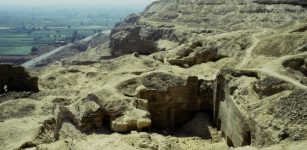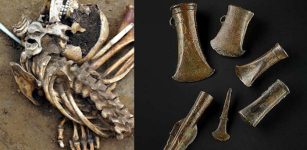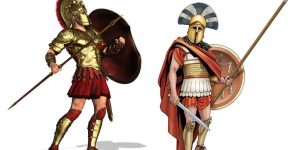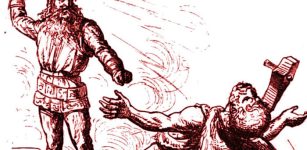Simon Magus ‘The Magician’ Who Faked Death And Resurrection
A. Sutherland - AncientPages.com - Simon the Sorcerer (or Simon the Magician) is a Biblical figure and Samaritan religious leader mentioned in Acts 8: 9-24. He lived at the turn of the 1st-2nd century AD and was a magician and miracle worker.
Simon's fall – a painting byBenozzo Gozzoli, 1462). Public Domain
He was born in an ancient village called Gitta (Gitton) in the country of Samaria, which historical and Biblical name is related to the central region of the Land of Israel, bordered by Judea to the south and Galilee to the north. Simon's name became famous, and people called him "Magus" because of his magic arts and also because, in his teachings, he announced himself as the "great power of God." Thus, he won many followers.
Often regarded as the founder of Gnosticism, Simon the Magus wished to obtain the power to perform miracles from the apostles. Other sources portray him as the individual responsible for the eclectic fusion of stoicism and Gnosticism, known as "The Great Pronouncement." 1
He used to practice black magic and astonished the people of Samaria and claimed to be something extraordinary. Still, many early Christians did not trust the Magician Simon Magus. He was considered a representation of Satan, who came to earth to alter and mislead the true faith. St. Cyril of Jerusalem, a theologian of the early Church, wrote that he was "the first Dragon of evil" who was "cast into hell." For other contemporary high-ranking members of the clergymen, he was the symbol of unrest, sin, and falsehood and the one through whom "all heresies came."
Nevertheless, like many of his fellow citizens, Simon was baptized, showing unity with the community of believers devoted to Jesus Christ. His attempts to show his true, inner dedication to the faith of Christ failed because he never had such commitment, but only selfish reasons to baptize.
The Apostles Paul and Peter confront Simon Magus before Nero, as painted by Filippino Lippi - Public Domain
He hoped to gain greater magical power and thus to increase his influence in society. All he wanted was to receive the opportunity to perform miracles for money. He offered the same money to the Apostles Peter and John, desiring them to grant him the magical power necessary for miraculous manifestations.
The Apostles warned Simon Magus of his actions' wickedness and rejected him. He left Christianity and created a Simonite sect dedicated to the master of divine worship, and he played a religious role. His mystical concept became popular in some circles, and his believers considered him as God (or Father) in human form. He was even sometimes worshiped as the incarnation of the Greek god Zeus.
He has received several faithful followers who honored him with a statue that stood in ancient Rome. His consort Helen was regarded by his followers as the earthly manifestation of the Greek goddess Athena.
Simon's scripture circulated under the name" the Great Annunciation," and almost all surviving testimonies about the life and views of Simon the Magus are included in ancient Christian writings. His doctrine has been long a subject of polemics.
The death of Simon Magus, from the Nuremberg Chronicle. Public Domain
It is challenging to present an accurate image of this controversial religious figure because he was often presented differently.
The Christian tradition has it that a remarkable and mystical duel took place between St. Peter and Simon at the Roman Forum in Rome, during the reign of the emperor Claudius (41 – 54 C). Simon the Magician was glorified by followers fascinated by his miracle-working. He wanted to demonstrate even more of his so-called skills. However, there has never been found any archaeological verification of this claim.
A legend says that Simon fell to his death from the Roman Forum when he attempted to demonstrate his ability to fly and once again impress the crowd. He was known to levitate and fly at will. At first, using his magic arts, Simon attempted to fake death and resurrection in the presence of the fifth Roman emperor Nero (54–68 CE), stepson and heir of the emperor Claudius, thus clearly ridiculing Christian doctrine.
At last, he desired to present the ascension, and while he was trying to fly Simon instead, he fell to his death from the Roman Forum to demonstrate his ability to fly and impress the crowd again.
Written by – A. Sutherland - AncientPages.com Senior Staff Writer
Copyright © AncientPages.com All rights reserved. This material may not be published, broadcast, rewritten or redistributed in whole or part without the express written permission of AncientPages.com
Expand for referencesReferences:
- Encyclopedia Britannica & Doniger W., Britannica Encyclopedia of World Religions
Mead G. R. S., Simon Magus
More From Ancient Pages
-
 Underground Hellenistic Necropolis With Tombs With Frescoes, Reliefs Unearthed In Naples, Italy
Archaeology | May 13, 2023
Underground Hellenistic Necropolis With Tombs With Frescoes, Reliefs Unearthed In Naples, Italy
Archaeology | May 13, 2023 -
 Indian Black Earth And Biodiversity Of The Amazon – New Study
Archaeology | Jun 24, 2020
Indian Black Earth And Biodiversity Of The Amazon – New Study
Archaeology | Jun 24, 2020 -
 Lemko People – European Minority That Lost Their Homeland And Still Live In Exile
Civilizations | Jan 13, 2020
Lemko People – European Minority That Lost Their Homeland And Still Live In Exile
Civilizations | Jan 13, 2020 -
 Egyptian Necropolis Of Asyut And Funerary Culture That Dates Back To Old Kingdom
Archaeology | Feb 24, 2020
Egyptian Necropolis Of Asyut And Funerary Culture That Dates Back To Old Kingdom
Archaeology | Feb 24, 2020 -
 Ancient DNA Reveals Bronze Age Women Altered Genetic Landscape Of Orkney
Archaeology | Feb 7, 2022
Ancient DNA Reveals Bronze Age Women Altered Genetic Landscape Of Orkney
Archaeology | Feb 7, 2022 -
 Mystery Of Pre-Adamic Didanum Race: Giants Who Were Ancestors Of The Nephilim and Rephaim
Biblical Mysteries | Oct 2, 2014
Mystery Of Pre-Adamic Didanum Race: Giants Who Were Ancestors Of The Nephilim and Rephaim
Biblical Mysteries | Oct 2, 2014 -
 Vikings’ Hideouts, Harbours And Homes: How Norse Warriors Owed Their Success To Their Encampments
Featured Stories | Feb 17, 2023
Vikings’ Hideouts, Harbours And Homes: How Norse Warriors Owed Their Success To Their Encampments
Featured Stories | Feb 17, 2023 -
 Viking Cork Settlement Re-Writes Ancient History Of Ireland
Archaeology | Jan 16, 2018
Viking Cork Settlement Re-Writes Ancient History Of Ireland
Archaeology | Jan 16, 2018 -
 Hill Of 100,000 Crosses In Lithuania Survived Against All Odds
Featured Stories | May 23, 2017
Hill Of 100,000 Crosses In Lithuania Survived Against All Odds
Featured Stories | May 23, 2017 -
 Impressive Gaulcross Hoard Reveals Secrets Of Mysterious Picts
News | Jun 20, 2016
Impressive Gaulcross Hoard Reveals Secrets Of Mysterious Picts
News | Jun 20, 2016 -
 DNA Study Sheds New Light On Ancient Britain’s Language, Ancestry, Kinship, Milk
Archaeology | Dec 26, 2021
DNA Study Sheds New Light On Ancient Britain’s Language, Ancestry, Kinship, Milk
Archaeology | Dec 26, 2021 -
 Who Were The Hoplites And What Was Their Armor Composed Of?
Ancient History Facts | Apr 20, 2018
Who Were The Hoplites And What Was Their Armor Composed Of?
Ancient History Facts | Apr 20, 2018 -
 Radar Discovers Mysterious Tunnels Under Sforza Castle As Depicted In Leonardo da Vinci’s Sketches
Archaeology | Feb 17, 2025
Radar Discovers Mysterious Tunnels Under Sforza Castle As Depicted In Leonardo da Vinci’s Sketches
Archaeology | Feb 17, 2025 -
 1,800-Year-Old Slab Engraved With Inscription Unearthed In Ruins Of Ancient City Of Hadrianapolis
Archaeology | Jan 5, 2020
1,800-Year-Old Slab Engraved With Inscription Unearthed In Ruins Of Ancient City Of Hadrianapolis
Archaeology | Jan 5, 2020 -
 Dangerous Anomaly Inside Mysterious European Mountain Remains Unexplained – Examining Evidence – Part 2
Ancient Mysteries | Mar 17, 2021
Dangerous Anomaly Inside Mysterious European Mountain Remains Unexplained – Examining Evidence – Part 2
Ancient Mysteries | Mar 17, 2021 -
 Did The 8 Omens Of The Aztecs Foretell The End Of Their Civilization?
Civilizations | Jan 30, 2020
Did The 8 Omens Of The Aztecs Foretell The End Of Their Civilization?
Civilizations | Jan 30, 2020 -
 Abu Simbel – Spectacular Ancient Egyptian Temples Unique In Design And Size
Featured Stories | Jun 12, 2021
Abu Simbel – Spectacular Ancient Egyptian Temples Unique In Design And Size
Featured Stories | Jun 12, 2021 -
 When And Why Negev Highlands’ Agricultural Settlement Was Abandoned? – Researchers Have Answers
Archaeology | Jul 28, 2020
When And Why Negev Highlands’ Agricultural Settlement Was Abandoned? – Researchers Have Answers
Archaeology | Jul 28, 2020 -
 Mount Nemrut: ‘Throne Of The Gods’ – Mysterious Royal Tomb Surrounded By Gigantic Sculptures
Civilizations | Nov 16, 2018
Mount Nemrut: ‘Throne Of The Gods’ – Mysterious Royal Tomb Surrounded By Gigantic Sculptures
Civilizations | Nov 16, 2018 -
 Giant Hrungnir Who Lost The Race And Engaged In A Deadly Duel With Mighty Thor In Norse Mythology
Featured Stories | Sep 19, 2018
Giant Hrungnir Who Lost The Race And Engaged In A Deadly Duel With Mighty Thor In Norse Mythology
Featured Stories | Sep 19, 2018



